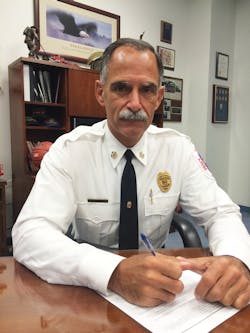Last month we talked about using the “luxury of time” to our advantage as well as learning when to just “shut up” as it pertains to social media. In this article, we’ll build on the luxury of time concept in the further discussion of our public safety mission.
Top-level change
In my 36 service years, I, like many of you, have watched the ebb and flow of people, tactics, best practices and evolving relationships among organizations. And like so many other things we once knew, we’ve seen the barriers to change slowly erode. While we’re pretty adept at adapting to change, I believe that the continuous ebb and flow of people is THE factor most responsible for our success AND our dysfunction at the top—in management and leadership.
We’ve seen it happen time and time again—with every change of chief, a change in direction and priorities. We can sugarcoat it however we’d like, but no organization will ultimately succeed with this revolving door at the top every year or two. The chief must take the helm, or constant change in purpose and direction will surely sink the ship. Further, we also need to fully recognize that no organization should be made or allowed to fall on the back of ONE person.
With this in mind, let’s focus on surviving top-change. Building solid partnerships and relationships in all directions will build a stronger organization that is better poised to survive.
Fear and relationship-building
Relationship-building can be difficult, but I submit that the ability to recognize the need for it, coupled with championing the associated complexities of relationship-building, is the crux of successful leadership—taking people where they NEED to be.
Successful relationships share one key trait—an understanding that neither side gets everything they want. In most successful business relationships, there are people or groups who may not like each other. Fortunately, “like” does not necessarily equal success. It would be nice to like everyone you have to work with, but you won’t.
So what is the single biggest impediment to successful relationship-building? Money? Trust? Entitlement? No, the single biggest impediment to successful relationship building is FEAR—fear of the unknown, fear of loss of control, fear of what others may think, fear of politics, etc.
Looking at mutual-aid response, I’ve probably heard thousands of excuses (fears) for why people will avoid relationship-building:
- “Fires burn differently here.”
- “THEY don’t know how WE do it.”
- “They’re just volunteers” or “They’re union.”
- “They can’t guarantee six people on the fire truck.”
- “Their chief is a jerk.”
We could spend volumes on each one of those excuses, but for this article, we’ll recognize the ISO’s three area types—urban, suburban and rural, with houses and industry scattered among them all.
As evidenced by Prince George’s County’s 2011 firestorm, any of us have the potential to find ourselves operating in any one of those environments at any time. Guess what? Fires burn the same there as they do in your community. Check that one off the list.
Are you using the NFPA and/or military firefighter and training standards, or at least some variation thereof? If so, then the only reason THEY don’t know how YOU do it is because one of you hasn’t reached out to the other! Drill and train with each other, build across first dues. We’re all here for the same reason, and I’ll bet you Grandma Jones doesn’t care how YOU do it. Check that one off the list.
Ahhh, the volunteer/union debate. I’ve been on both sides of that proverbial wall and fully recognize that there are bad apples on both sides. Let’s face it, we’re not going to solve this debate here, but we should acknowledge that Grandma Jones cares even less whether you’re paid or volunteer. Do the right thing, folks, and that does not involve dysfunctional performances at the front door of Grandma Jones’ burning home. Check that one off the list.
It’s difficult for a lot of departments to “guarantee” six people on every unit. An incident commander’s responsibility is to coordinate their scene. Whether that’s with 30 people or 13, they need to make sure the job gets done. The orchestra conductor doesn’t shut down the show if a couple players get sick. The music may not sound as good, but the show goes on. So should it be on our scenes, whether units show up with six or three. We adapt and overcome. Check that off the list. (And for the record, yes, we all WANT more people. While fewer than six is better than none, I personally don't advocate for any less than four on a fire response unit, allowing any unit to implement two-in, two-out when necessary.)
Every chief has been called a derogative term or name by people within and outside their organization, so get over it. Guess what? Your chief is the same. Check THAT off the list.
The point of all this is the fact that establishing automatic mutual-aid agreements among neighboring departments is essential to providing Grandma Jones the best possible service. I recognize we have a LOT of work to do on this, and I recognize that jurisdictional autonomy is important as well. The best case is probably somewhere in between. In the meantime, I encourage chiefs to recognize that they’re not on an island. Reach out and develop whatever memorandum of understanding or agreement that may be necessary, train with your neighboring departments, and drop the walls. Grandma Jones and the lives of your own people depend on it!
Beyond fire and EMS
Developing operational relationships goes beyond fire and EMS departments. Are you exercising with your police departments? What about public works and utilities? Transportation and towing? Private industry? Emergency management? NGOs? The 9-1-1 center? The residential community? How about other regional fire departments? It’s always great to see a well-run Emergency Operations Center (EOC) where all of the affected entities are represented and engaged. They’re only engaged because someone worked to BUILD that relationship.
Emergency managers can’t and shouldn’t try to do it all. Fire departments have unique issues that require their specific engagement: fire protection systems, capacity concerns, fire/medical safety training, on-scene incident management expectations, etc. Fire and EMS departments also have shared responsibilities in roadway incidents and industrial events. It doesn't make sense to operate in your own bubble when you have multiple agencies, some with statutory responsibilities, on “your” scene.
You’ll never address these concerns proactively or operate on those scenes effectively if you don’t create the relationships and build the partnerships. People are much more likely to be your advocate than your adversary if they’ve met you in advance, exercised with your people, and understand all of the on-scene roles.
Businesses and community members will provide valuable information from a fire problem perspective and will allow you to manage expectations in advance. It’s important when you’re cultivating these relationships that you’re not making promises on which you can't legally or realistically deliver. It is critical that you maintain strong ethical standards that ensure the fire safety code (laws, rules, procedures) is sensibly enforced. We must ensure the highest levels of safety possible for our communities. That’s our JOB.
You’re not giving anything up by “allowing” someone else into your response district. By engaging all those other entities, you’ll not only learn their perspective, but you will also gain additional eyes and ears in the community, build positive relationships, and ensure on-scene management is smoother than it would be otherwise.
Making sure your politicians and local/state budget folks understand your issues is one of the more important partnerships you’ll need to build. You’re mistaken if you think your mere election or appointment is enough. Building long-term strategic looks for your department is critical to this discussion. This should include the practical components of programs, like the IAFF’s “FireOps 101,” along with honest and forthright assessments of your department’s administration.
Likely running afoul of some in our industry, I admit that I've never been a fan of BIG strategic plans, in and of themselves. While this is not a universal recognition, more often than not, we find those big strategic plans sitting on a shelf gathering dust. Acknowledging some large strategic plans have had great value, I have seen greater success using a series of mini strategic plans that provide smaller bites of information/focus that are easier to digest while building those political and fiduciary relationships. Using the mini-strategic plan paradigm, it is important for the chief and staff to keep the interconnective pieces in mind while coalescing documents for presentation. You may find the mini-strategic plan process laborious; however, the demonstrable results will be worth much more than the effort, as you bring politicians and budget folks into your realm of understanding.
Final thoughts
It’s easy to build relationships and partnerships. You need to understand your legal boundaries and political realities while venturing out on this journey. I encourage you to avoid letting a “wall” stop you in bringing people together; there's always another way around.
Relationship-building is definitely an area where you need to lead from the front. Show your folks your expectations and level of engagement. They’ll come to understand how important that engagement is, and before you know it, they’ll be emulating your lead. They’ll also emulate your lead if you’re sitting on the couch like a bump on a log.
You need to build successful relationships to build a successful department. These relationships and partnerships will endure changes at the top. Without those established relationships, the new guy or gal has a blank slate and may or may not run roughshod over the department. Our future depends on our collective success. You want to build successful relationships and partnerships? Use the luxury of time to take that first step, make that first call, attend that first meeting. What are YOU afraid of?

Marc S. Bashoor
MARC S. BASHOOR joined the fire service in 1981. In 2017, he retired as fire chief of Prince George’s County, MD, Fire/EMS, the largest combination department in North America. His progressive community-based approach led to record hiring and a strategic apparatus replacement plan.
Twitter: @ChiefBashoor
Email: [email protected]






